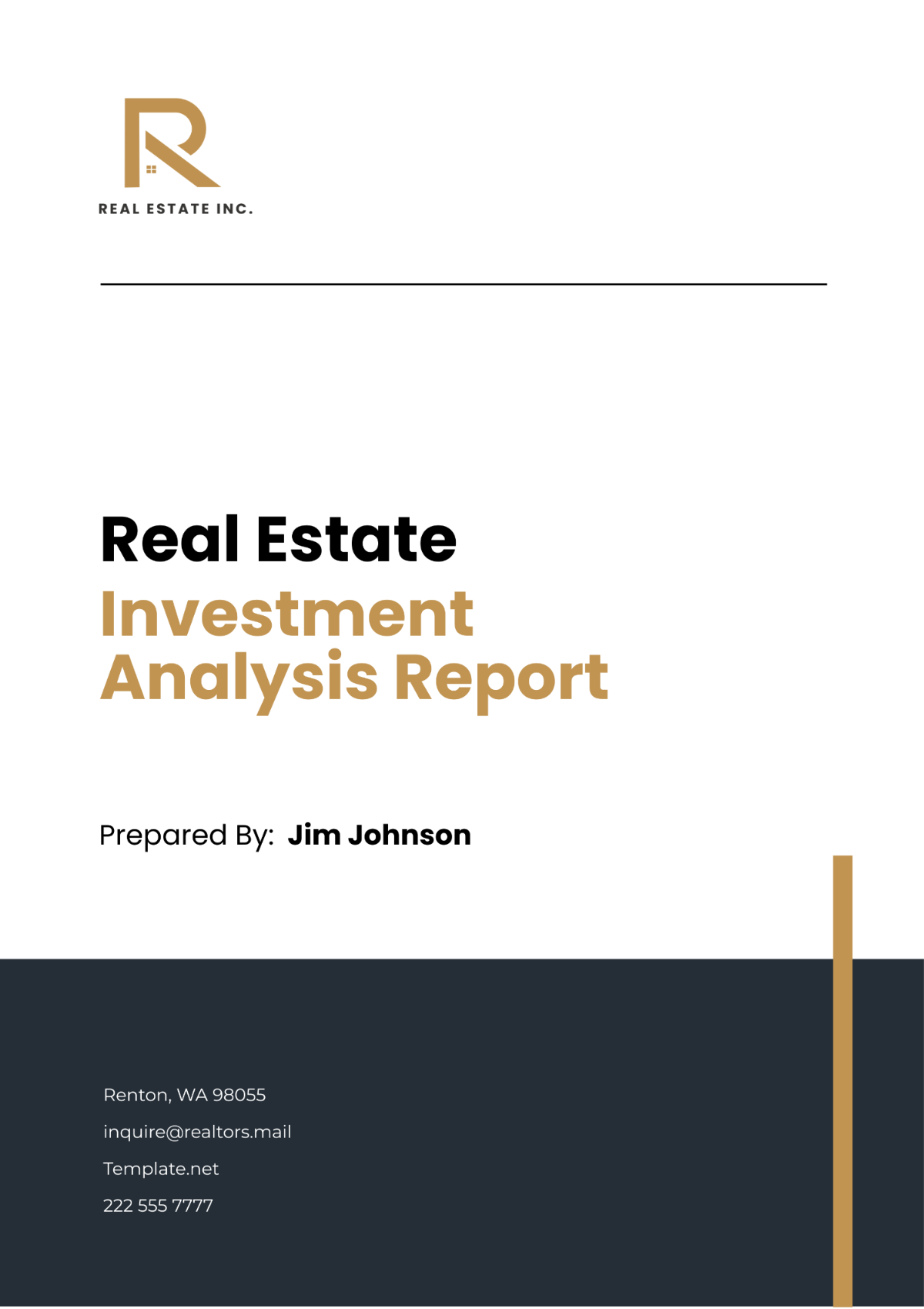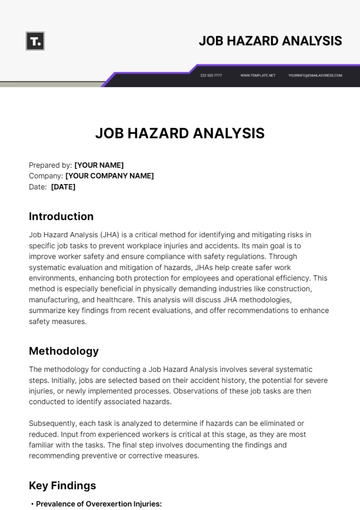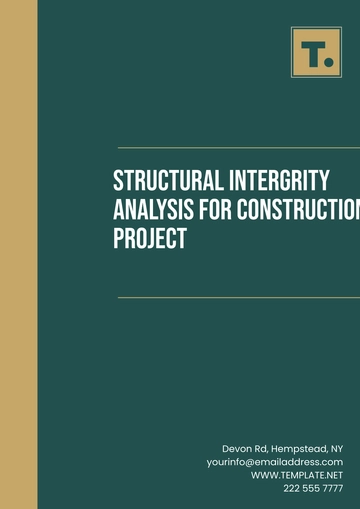Free Real Estate Investment Analysis Report

1. Executive Summary
This Real Estate Investment Analysis Report has been meticulously made by [Your Name], serving [Your Company Name], to offer a profound and encompassing scrutiny of the potential investment opportunity presented by the designated property. Through the examination of current market value, income-generating capabilities, operational expenditures, and both macroeconomic and microeconomic factors influencing the real estate sector, this document aims to furnish [Your Company Name] with actionable insights and informed predictions to aid in strategic investment decision-making.
2. Property Market Value and Income-generating Potential
Current Market Value | $1,000,000 |
Annual Rental Income | $150,000 |
Other Income | $25,000 |
Total Annual Income | $175,000 |
The property, with a current market valuation of $1,000,000, stands as a lucrative investment opportunity, showcasing a strong capacity for income generation. Annually, it is expected to yield a rental income of $150,000, further bolstered by additional income streams amounting to $25,000. Collectively, these figures elevate the property’s total annual income to an impressive $175,000. This income potential is not just a reflection of the property's inherent value but also indicative of its strategic positioning within a buoyant market, where demand remains high, and rental yields are attractive. The following subheadings delve deeper into the facets contributing to this financial outlook:
Market Trends and Growth Potential
The property's significant market value and income potential are underpinned by favorable market trends, including rising demand in the area, limited supply of comparable properties, and potential for rental market growth. These trends not only bolster the current valuation but also promise appreciable capital gains in the future.
Strategic Location and Desirability
Situated in a prime location that boasts accessibility, excellent amenities, and a strong community vibe, the property stands out as a highly desirable option for potential tenants. This desirability is a key driver of the property's income-generating potential, ensuring high occupancy rates and a competitive rental price point.
Diversified Income Streams
Beyond traditional rental income, the property’s strategy includes leveraging additional income streams such as parking fees, storage units, or service charges. These not only contribute to the total annual income but also mitigate risk by diversifying revenue sources, making the investment more resilient against market fluctuations.
3. Operating Expenses and Cash Flow Projections
In this section, we delve into the financial stewardship required to maintain and enhance the property's value and profitability. With a keen eye on operating expenses totaling $50,000 annually, the property is poised to yield a robust annual net income of $125,000. This calculation considers all necessary expenses, including property management, repairs, and maintenance, alongside property tax obligations. Each category of expense is scrutinized to ensure efficiency and cost-effectiveness, aligning with strategic goals to maximize return on investment while maintaining the property at its peak condition.
Annual Operating Expenses: $50,000
Annual Net Income: $125,000
Property Management Costs: $10,000
Repair and Maintenance Costs: $15,000
Property Tax: $20,000
Property Management Efficiency
Effective property management is crucial for sustaining high occupancy rates and ensuring tenant satisfaction. The allocated $10,000 covers all facets of property management, including tenant communication, lease management, and routine inspections, ensuring the property operates smoothly and efficiently.
Proactive Repair and Maintenance Strategy
An allocation of $15,000 towards repair and maintenance underlines a proactive approach to property upkeep. This investment not only preserves the property’s value but also enhances tenant retention by addressing issues promptly and maintaining high standards of living.
Strategic Property Tax Planning
With $20,000 set aside for property taxes, this segment emphasizes the importance of strategic financial planning in managing significant expenses. Efforts to stay abreast of tax changes and potential savings are pivotal in optimizing cash flow and maximizing net income.
4. Recommendations and Tax Implications
In this section, we pivot towards strategic actions and tax considerations that can significantly enhance the property's value and its income-generating capacity for [Your Company Name]. By meticulously crafting property improvement initiatives and adopting innovative rental income enhancement strategies, the potential for capital appreciation and investment returns skyrockets. Additionally, a thorough analysis of tax implications sheds light on the necessity for sophisticated financial planning. Such strategic foresight not only ensures compliance with tax regulations but also leverages opportunities for tax savings, thereby optimizing overall investment returns.
A. Enhancing Property Value Through Strategic Improvements
Investing in targeted property enhancements can dramatically increase both the property's market value and its appeal to potential tenants. Recommendations may include modernizing facilities, upgrading security features, or enhancing curb appeal, each tailored to boost rental demand and command higher rental rates.
Improvement Area | Description | Expected Outcome | Estimated Cost | Projected Value Increase |
|---|---|---|---|---|
Modernization | Updating interiors, appliances, and technology to contemporary standards. | Increased tenant satisfaction and higher rents. | $30,000 | 5% increase in value |
Security Upgrades | Enhancing security with modern systems and surveillance. | Improved safety perception and demand. | $15,000 | 3% increase in value |
Curb Appeal Enhancement | Landscaping and facade improvements. | Attracting more prospective tenants. | $20,000 | 4% increase in value |
These improvements are aimed at not only increasing the property's market value and attractiveness but also ensuring it remains competitive, with the added benefit of commanding higher rental rates.
B. Maximizing Rental Income
By implementing dynamic rental strategies such as flexible lease terms, value-added services, and competitive pricing, [Your Company Name] can significantly increase its rental income streams. Exploring and integrating innovative revenue-generating amenities will further distinguish the property in a competitive market.
Strategy | Description | Expected Impact | Estimated Revenue Increase |
|---|---|---|---|
Flexible Lease Terms | Offering leases from 3 months to 2 years. | Broader appeal and reduced vacancies. | 10% increase in occupancy |
Value-added Services | Integrating services like cleaning and internet. | Higher rental value through services. | 5% increase in rental income |
Competitive Pricing | Pricing properties competitively after market analysis. | Balance between occupancy and revenue. | 7% increase in annual income |
Innovative Amenities | Adding smart home tech and fitness centers. | Enhanced desirability and higher rents. | 6% increase in rental income |
The dynamic strategies outlined are designed to optimize [Your Company Name]'s rental income streams by leveraging market trends and tenant preferences, thereby increasing overall revenue potential.
C. Navigating Tax Implications for Maximum Benefit
A detailed examination of the tax landscape is imperative to uncovering avenues for tax efficiency and savings. Strategies such as capitalizing on depreciation, exploiting tax deductions, and understanding the impact of local and federal tax laws are essential for minimizing tax liabilities while maximizing cash flow and net returns.
Tax Strategy | Description | Benefit | Potential Savings |
|---|---|---|---|
Depreciation | Leveraging depreciation of property and improvements over time. | Reduces taxable income, lowering tax liability | $10,000 annually |
Tax Deductions | Identifying deductible expenses such as repairs and management fees. | Lowers taxable income, increasing savings. | $5,000 annually |
Tax Law Awareness | Staying informed on tax law changes. | Allows strategic financial planning. | Varies |
These tax strategies are crucial for minimizing tax liabilities and maximizing cash flow and net returns. By implementing these strategies, [Your Company Name] can leverage tax efficiencies to enhance the investment's profitability.
5. Market Analysis and Economic Indicators
Understanding the broader economic landscape is crucial for [Your Company Name] as it navigates the complexities of real estate investment. This section offers a deep dive into how local and national economic indicators such as GDP growth rates, employment statistics, and interest rates shape the real estate market dynamics, influencing both property values and rental market trends. By analyzing these indicators, [Your Company Name] gains insights into economic cycles, demand fluctuations, and potential investment hotspots, enabling more informed decision-making and strategic positioning in the market.
A. GDP Growth Rates
The Gross Domestic Product (GDP) growth rate is a vital indicator of economic health and a driver of real estate demand. A rising GDP indicates economic expansion, which can lead to increased demand for both residential and commercial properties, driving up values and rental rates. Conversely, a contracting GDP can signal a downturn, affecting property investments adversely.
Year | GDP Growth Rate | Impact on Real Estate Market |
|---|---|---|
[Year] | 4.0% | Increased demand for both residential and commercial properties, leading to a rise in property values and rental rates. |
[Year] | 2.5% | Steady growth contributing to sustained real estate demand, albeit at a slower pace. |
[Year] | -1.0% | Economic contraction leading to decreased demand, affecting property investments adversely. |
Insight: A correlation exists between GDP growth rates and real estate demand, with positive growth enhancing market conditions and contractions posing challenges.
B. Employment Statistics
Employment levels directly impact the real estate market, with higher employment rates boosting housing demand and, subsequently, property prices and rents. Employment trends in specific sectors can also provide valuable insights, as growth in high-paying industries may lead to increased demand for premium real estate segments.
Year | Unemployment Rate | Sector with Highest Growth | Impact on Real Estate Market |
|---|---|---|---|
[Year] | 5.0% | Technology | Increased demand in high-tech hubs, driving up property prices and rents. |
[Year] | 4.5% | Health & Wellness | Growth in the health sector fuels demand for residential and commercial spaces in proximity to healthcare facilities. |
[Year] | 6.0% | Renewable Energy | Rising unemployment affects overall housing demand negatively, though renewable energy sector growth presents niche opportunities. |
Insight: Employment rates and sector-specific growth are significant predictors of real estate market trends, with higher employment generally boosting demand across the board.
C. Interest Rates
Interest rates play a critical role in real estate investment decisions. Lower interest rates reduce the cost of borrowing, making property purchases more attractive and potentially leading to a market uplift. On the other hand, higher interest rates can cool down an overheated market by increasing borrowing costs, thus affecting buyers' purchasing power and investment yields.
Year | Average Interest Rate | Impact on Real Estate Market |
|---|---|---|
[Year] | 3.0% | Lower borrowing costs lead to increased property purchases and investment, uplifting the market. |
[Year] | 4.5% | Moderate increase in interest rates begins to temper the pace of real estate transactions. |
[Year] | 6.0% | Higher borrowing costs cool down the market, affecting affordability and reducing buyer activity. |
Insight: Interest rates significantly influence real estate investment decisions, with lower rates encouraging borrowing and investment, and higher rates having a cooling effect on the market.
By keeping a pulse on these economic indicators, [Your Company Name] can anticipate market shifts, adapt strategies accordingly, and optimize its real estate portfolio for maximum return on investment. This comprehensive analysis supports strategic planning and risk management, ensuring the company's investments are aligned with economic trends and market potentials.
6. Investment Strategy and Return Analysis
In navigating the complexities of the real estate market, [Your Company Name]'s investment strategy is meticulously crafted to prioritize long-term growth, minimize risks, and maximize returns. This holistic approach is supported by detailed financial modeling and analysis, taking into account various economic scenarios to forecast investment performance. By scrutinizing key financial metrics—Internal Rate of Return (IRR), Net Present Value (NPV), and Capitalization Rate (Cap Rate)—the strategy aims to provide a robust framework for evaluating the financial health and potential of real estate investments. This comprehensive analysis ensures that [Your Company Name] is positioned to make informed decisions that align with its investment goals and market opportunities.
A. Long-Term Growth Projection
Focusing on long-term growth, this strategy leverages market trends and demographic shifts to identify properties with strong appreciation potential. Investments are chosen not only for their immediate returns but also for their capacity to increase in value over time, contributing significantly to the portfolio's overall growth.
Factor | Description | Impact on Strategy | Projected Growth (%) |
|---|---|---|---|
Market Trends | Analysis of current and emerging real estate trends | Identification of high-growth potential properties | 5-7% annually |
Demographic Shifts | Changes in population dynamics and preferences | Focusing on properties in high-demand areas | 6-8% over 10 years |
Economic Indicators | GDP growth, employment rates, and interest rates | Adjusting investment focus based on economic health | 4-6% annually |
This table highlights the factors considered in projecting long-term growth, with an emphasis on identifying properties that are well-positioned to benefit from market trends, demographic shifts, and positive economic indicators.
B. Risk Mitigation Tactics
Risk mitigation is integral to the investment strategy, employing diversification, thorough market research, and contingency planning to safeguard against market volatility and unforeseen challenges. This proactive approach ensures that potential risks are identified and addressed before they can impact the investment's performance.
Risk Factor | Mitigation Strategy | Implementation Method | Effectiveness |
|---|---|---|---|
Market Volatility | Diversification across geographies and property types | Reducing dependency on single market performances | High |
Economic Downturns | Thorough market research and analysis | Early identification of potential downturns | Moderate to High |
Unforeseen Challenges | Contingency planning | Establishment of financial reserves and insurance | Moderate to High |
This table outlines the key risk factors facing real estate investments and the strategies employed by [Your Company Name] to mitigate these risks. Diversification, thorough research, and contingency planning are central to the company's approach to minimizing potential impacts on investment performance.
C. Maximizing Returns
Maximization of returns is achieved through strategic asset management, including efficient property operations, targeted improvements, and dynamic leasing strategies. By optimizing every aspect of property management, [Your Company Name] aims to enhance income generation and capitalize on opportunities to increase the value of its investments, thereby achieving superior returns.
Strategy Component | Description | Implementation Approach | Projected Increase in Returns |
|---|---|---|---|
Efficient Property Operations | Streamlining operations for cost efficiency | Adoption of technology and best practices | 2-3% annually |
Targeted Improvements | Investing in property upgrades and amenities | Focused improvements based on tenant preferences | 3-5% per project |
Dynamic Leasing Strategies | Flexible and competitive leasing terms | Market analysis and competitive pricing strategies | 1-2% annually |
This table presents the strategies [Your Company Name] employs to maximize returns, detailing the approaches to enhancing property operations, making targeted improvements, and employing dynamic leasing strategies. Each component is designed to optimize income generation and capitalize on value-increasing opportunities, contributing to superior overall returns.
This investment strategy, underpinned by rigorous analysis and a forward-looking perspective, equips [Your Company Name] with the insights and tools needed to navigate the real estate market successfully. It highlights the company's commitment to strategic growth, risk management, and the pursuit of excellence in investment performance.
7. Conclusion
The comprehensive Real Estate Investment Analysis Report prepared for [Your Company Name] represents a meticulous synthesis of market analysis, economic indicators, and strategic planning, aimed at equipping the company with the knowledge and insights required for judicious investment decisions in the dynamic realm of real estate. By delving into the nuances of GDP growth rates, employment statistics, interest rates, and their cumulative effects on the real estate market, this report provides a macroeconomic foundation upon which micro-level investment strategies are constructed.
The detailed exploration of long-term growth projections underscores the significance of aligning investment choices with broader market trends and demographic shifts, highlighting properties with strong potential for appreciation. This foresight into economic health and market demand, backed by actionable data and projections, serves to steer [Your Company Name] towards investments that promise sustainable growth and resilience against market fluctuations.
Risk mitigation tactics detailed within this report offer a strategic roadmap for safeguarding [Your Company Name]'s investments against volatility and unforeseen challenges. The emphasis on diversification, comprehensive market research, and contingency planning is designed to insulate the portfolio from economic downturns and enhance its stability, ensuring that [Your Company Name] remains well-positioned to navigate through periods of uncertainty with confidence.
Moreover, the strategies outlined for maximizing returns through efficient property operations, targeted improvements, and dynamic leasing strategies reflect a deep understanding of the operational nuances that drive profitability in real estate investments. These recommendations are tailored to enhance income generation, optimize operational costs, and elevate property values, thereby maximizing returns on investment. The projected increases in returns, grounded in empirical analysis and strategic insights, underscore the potential for [Your Company Name] to achieve superior financial performance and capital growth.
Therefore, this Real Estate Investment Analysis Report synthesizes comprehensive market insights, financial analysis, and strategic recommendations to chart a course for [Your Company Name] towards achieving its investment objectives. It represents not just a roadmap for navigating the complexities of real estate investment but also a blueprint for strategic growth, risk management, and return maximization. By leveraging the insights and strategies detailed within, [Your Company Name] is well-equipped to make informed, strategic investment decisions, positioning itself for success in the competitive landscape of real estate investment.
- 100% Customizable, free editor
- Access 1 Million+ Templates, photo’s & graphics
- Download or share as a template
- Click and replace photos, graphics, text, backgrounds
- Resize, crop, AI write & more
- Access advanced editor
The Real Estate Investment Analysis Report Template from Template.net is a must-have for Marketing Professionals. Easily editable in our Ai Editor Tool, it simplifies complex data interpretation. This customizable report offers a clear, concise view of property investment viability. You'll appreciate the time saved and accuracy achieved. Try this editable, customizable tool today and optimize your real estate investment prospects.





























